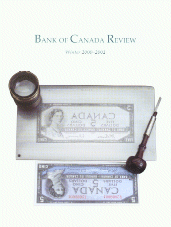Winter 2000-2001

|
Dynamic General-Equilibrium Models and Why the Bank of Canada is Interested in Them by Kevin Moran
The Bank of Canada's Management of Foreign Currency Reserves
The Federal Government's Use of Interest Rate Swaps and Currency Swaps
See also: Tables A1, A2, and Notes to the Tables |
Cover: Intaglio Master Plate—Bank of Canada, 1954 Series $5
Paper money is a complex, aesthetic blend of features that provides information in a secure and durable framework. A significant component of that security is the intaglio print.Intaglio—the fine art of engraving—involves printing an image from a design that has been cut or etched into a metal plate like the one shown on the cover. This process has been used extensively in bank note production since the eighteenth century because it produces distinctive features that cannot be duplicated in other printing processes. The most characteristic of these is tactile relief. As paper is squeezed under pressure into the engraved line of the inked intaglio plate, it deforms and picks up ink. The combination of deformed paper and ink deposits creates the rough texture of new notes.
All notes issued by the Bank of Canada since 1935 have incorporated intaglio-printed elements in their designs. These include portraits, lettering, or guilloche patterns (ornate designs often composed of elaborate “s”-shaped curves).
Individual dies are prepared for each element and then put onto one master plate like that shown here. Text and images are in reverse so that the design is not backwards when it is transferred to the paper. When this plate for the 1954 series $5 note was produced, the individual elements were transferred to one plate through a process called siderography. In this process, steel rollers are slowly rocked back and forth over the individual dies picking up the image. The rollers are then hardened and subsequently used to transfer the design to a single master plate, which, in turn, is hardened and used as a starting point in the production of large plates carrying multiple images of the note.
The engraving process is costly. A single handmade portrait may take months to prepare and cost thousands of dollars to produce. At the same time, pains-taking care and attention to detail are required. A slip of the engraving tool may invalidate weeks of work.
The intaglio plate shown here is made of steel and measures approximately 8 1/4 x 4 3/4 inches. Together with the note, the engraver's chisel, and eyeglass, it is part of the National Currency Collection, Bank of Canada.
Photography by James Zagon.




